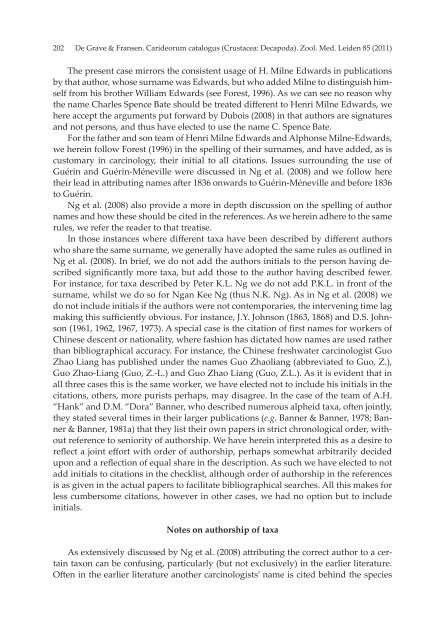Part 1 - AToL Decapoda
Part 1 - AToL Decapoda
Part 1 - AToL Decapoda
You also want an ePaper? Increase the reach of your titles
YUMPU automatically turns print PDFs into web optimized ePapers that Google loves.
202 De Grave & Fransen. Carideorum catalogus (Crustacea: <strong>Decapoda</strong>). Zool. Med. Leiden 85 (2011)<br />
The present case mirrors the consistent usage of H. Milne Edwards in publications<br />
by that author, whose surname was Edwards, but who added Milne to distinguish himself<br />
from his brother William Edwards (see Forest, 1996). As we can see no reason why<br />
the name Charles Spence Bate should be treated different to Henri Milne Edwards, we<br />
here accept the arguments put forward by Dubois (2008) in that authors are signatures<br />
and not persons, and thus have elected to use the name C. Spence Bate.<br />
For the father and son team of Henri Milne Edwards and Alphonse Milne-Edwards,<br />
we herein follow Forest (1996) in the spelling of their surnames, and have added, as is<br />
customary in carcinology, their initial to all citations. Issues surrounding the use of<br />
Guérin and Guérin-Méneville were discussed in Ng et al. (2008) and we follow here<br />
their lead in attributing names after 1836 onwards to Guérin-Méneville and before 1836<br />
to Guérin.<br />
Ng et al. (2008) also provide a more in depth discussion on the spelling of author<br />
names and how these should be cited in the references. As we herein adhere to the same<br />
rules, we refer the reader to that treatise.<br />
In those instances where different taxa have been described by different authors<br />
who share the same surname, we generally have adopted the same rules as outlined in<br />
Ng et al. (2008). In brief, we do not add the authors initials to the person having described<br />
significantly more taxa, but add those to the author having described fewer.<br />
For instance, for taxa described by Peter K.L. Ng we do not add P.K.L. in front of the<br />
surname, whilst we do so for Ngan Kee Ng (thus N.K. Ng). As in Ng et al. (2008) we<br />
do not include initials if the authors were not contemporaries, the intervening time lag<br />
making this sufficiently obvious. For instance, J.Y. Johnson (1863, 1868) and D.S. Johnson<br />
(1961, 1962, 1967, 1973). A special case is the citation of first names for workers of<br />
Chinese descent or nationality, where fashion has dictated how names are used rather<br />
than bibliographical accuracy. For instance, the Chinese freshwater carcinologist Guo<br />
Zhao Liang has published under the names Guo Zhaoliang (abbreviated to Guo, Z.),<br />
Guo Zhao-Liang (Guo, Z.-L.) and Guo Zhao Liang (Guo, Z.L.). As it is evident that in<br />
all three cases this is the same worker, we have elected not to include his initials in the<br />
citations, others, more purists perhaps, may disagree. In the case of the team of A.H.<br />
”Hank” and D.M. ”Dora” Banner, who described numerous alpheid taxa, often jointly,<br />
they stated several times in their larger publications (e.g. Banner & Banner, 1978; Banner<br />
& Banner, 1981a) that they list their own papers in strict chronological order, without<br />
reference to seniority of authorship. We have herein interpreted this as a desire to<br />
reflect a joint effort with order of authorship, perhaps somewhat arbitrarily decided<br />
upon and a reflection of equal share in the description. As such we have elected to not<br />
add initials to citations in the checklist, although order of authorship in the references<br />
is as given in the actual papers to facilitate bibliographical searches. All this makes for<br />
less cumbersome citations, however in other cases, we had no option but to include<br />
initials.<br />
Notes on authorship of taxa<br />
As extensively discussed by Ng et al. (2008) attributing the correct author to a certain<br />
taxon can be confusing, particularly (but not exclusively) in the earlier literature.<br />
Often in the earlier literature another carcinologists’ name is cited behind the species

















